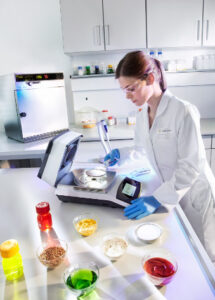
This article will discuss how moisture analyzers work and the best ways to use them.
Moisture analyzers measure the moisture content in samples. They analyze liquids, solids, and certain types of products like food, plastics, fuel, and pharmaceuticals. This article will discuss how moisture analyzers work and the best ways to use them.
How do Moisture Analyzers Work?
Moisture analyzers work using a Loss on Drying (LOD) method to confirm how much moisture is in the sample. Here are the following steps:
- The moisture balance weighs the sample and records the initial weight
- Secondly, a heating element radiates heat to dry the sample. There are various heating elements such as quartz, halogen, ceramic, and metal.
- Thirdly, the balance weighs the sample until the sample is thoroughly dried.
- Lastly, determine the moisture content by calculating the difference between the final weight and the initial weight.
In addition, you can calculate the moisture content from the initial weight if you need to discover the solid content of a sample. Remember that moisture can also include any substance evaporating from heating, such as organic solvents and alcohols.
What are the Best Practices for Using Them?
Moreover, the following tips will help ensure you receive accurate results when using a moisture analyzer.
· Position the analyzer correctly in a clean environment. Avoid extreme temperatures, high humidity, and excess dust since they can impact the accuracy of results.
· Examine the risk of heating your specific sample and take safety precautions.
· Use clean sample pans and dispose of them immediately after use.
· Also, you must cover the whole surface area of the pan with an even sample spread.
· Be sure not to overload the unit since it can damage the internal weighing mechanisms.
· Most importantly, calibrate the heating module and weighing unit at regular intervals.
The Effect of Sample Mass on Measurement Accuracy
Furthermore, you’ll receive accurate results if the sample is evenly spread over the whole pan. But what sample size do you use? There are multiple considerations when choosing the appropriate sample size. A higher sample mass will lead to moisture determination taking longer. Additionally, the heat distribution might be odd in a significant sample, producing lower precision. Overall, a larger sample leads to a longer process, lower precision, and enhanced repeatability.
CONTACT THE SCALE PEOPLE FOR WEIGHING EQUIPMENT AND CALIBRATION SERVICES!
Since 1956, The Scale People have earned a reputation as the finest service provider for calibration and repairs of weighing equipment in the mid-Atlantic area. Our sales team can help work with you to find the best weighing equipment for your application. We currently have offices in Columbia, MD, and Newport News, VA, but we offer our services nationwide. Over the years, we have built up a long list of satisfied clients from a wide variety of industries, including pharmaceutical, food and beverage, and government manufacturing. We are a fully ISO/IEC 17025:2017 accredited service company offering calibration for balances, scales, dynamometers, force measurement, test weights pipettes, and more. All of our services have a 100% satisfaction guarantee. We’re only a phone call away at +1 (800) 451-9593. To learn more about what we do, follow us on Facebook, Twitter, and LinkedIn.
